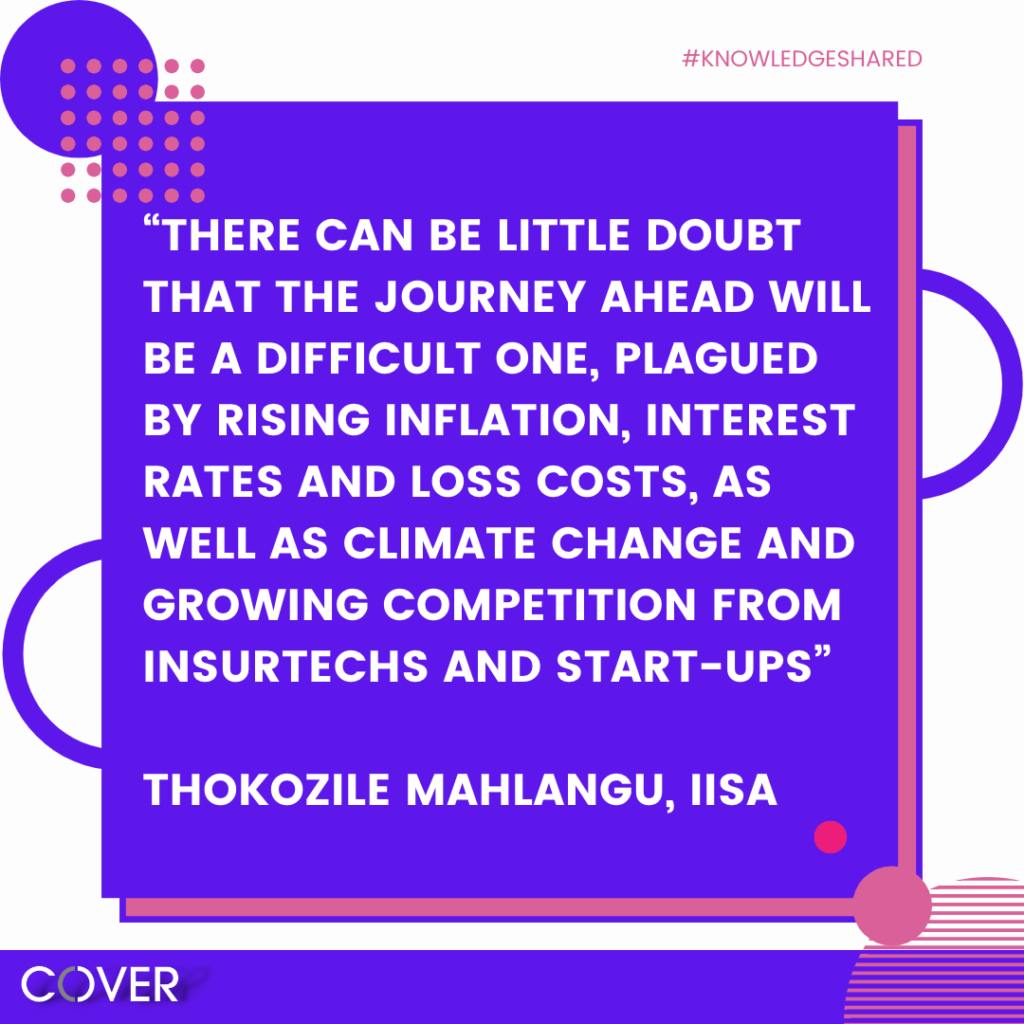By: Thokozile Mahlangu, CEO IISA
Following the devastating impact of the COVID-19 pandemic on the South African insurance industry over the past two years, 2022 has been a far better year for the sector, which has bounced back strongly from unprecedented business interruption claims.

According to a survey conducted by KPMG SA earlier this year, following the huge volumes and values of business interruption claims in 2020, due to COVID-19, the non-life insurance sector more than doubled profits to R12.1 billion in 2021.
The survey revealed that – as a whole – the local insurance industry reported gross written premiums (GWP) of R131.6 billion last year, which is up by 7% from 2021, in effect laying a solid foundation from which the industry is able to enter what now appears to be the tail end of the pandemic.
Despite this recovery, the insurance landscape remains somewhat volatile and dynamic, as new challenges and risks continue to emerge from climate change to struggling economies and political unrest. If the pandemic has taught the insurance industry anything it is to expect the unexpected.
An increasing number of insurance companies are realising that adaptability and flexibility are no longer an option but have become essential components of strategy, especially as the industry operates in an environment that is rapidly changing and increasing in complexity.
Insurers have indeed shown great resilience and flexibility in the face of a range of challenges, not only emanating from the pandemic, but also from the economic fallout from the ongoing European geopolitical conflict. We have seen systems and capabilities being improved, as well as the adoption of agile talent and technology strategies becoming key to gaining a competitive edge.
However, is the industry truly prepared for the emerging challenges as we head into 2023? There can be little doubt that the journey ahead will be a difficult one, plagued by rising inflation, interest rates and loss costs, as well as climate change and growing competition from insurtechs and start-ups.
While the uncertainties that are being driven by global challenges and economic forces make it difficult for insurers to navigate the emerging risk landscape, these risks also tend to be highly complex and interconnected. For instance, extreme weather patterns and natural disasters create vulnerabilities for businesses, as well as making workplaces potentially unsafe and properties unliveable.
In its 2023 Insurance Outlook, Deloitte notes that its research suggests that insurers should start shifting their focus from basic operational transformation—such as transitioning to cloud—to fully realise the value and benefits of infrastructure and technological upgrades.
It also urges insurance carriers to move away from simply responding to the requirements of regulators and other industry overseers to more proactively anticipating and fulfilling distributor and policyholder
expectations; and broaden their historical focus from risk and cost reduction to prioritise greater levels of experimentation and risk-taking that drives ongoing innovation, competitive differentiation and profitable growth.
Considering the potentially tricky operating environment that is likely to prevail in 2023 and beyond, it will also be key for insurance companies to start focusing on reducing operating costs with a view on long-term growth and sustainability.
As such, technology ecosystems are becoming a reality within the insurance space, according to Forbes, which states that insurance companies that have relied on legacy architecture are increasingly simplifying these systems, while also building a new modern technology stack. Other companies, that are further along the digital journey, are integrating emerging technologies and capabilities from insurtechs into their solution mix.

These companies are building technology ecosystems that are underpinned by flexible, scalable and resilient core offerings. These insurers understand that this is the way to maximise profitability and configure systems that scale-up as needed, as well as the quickest way to open avenues to added value.
For example, insurers should be exploring opportunities to automate parts of the claims process, while looking at use cases where chatbots and other digital customer service tools can drive customer satisfaction.
So, while as an industry, we can be proud of how far we’ve come in adapting to the demands of the modern world, this is definitely not the time to be resting on our laurels and feeling secure in the progress that we’ve made.
Instead, now is the time for insurance companies to build on the momentum they’ve achieved over the past few years in order to sustain an ongoing culture of innovation. At the same time, customer-centricity must become the focal point of the insurance sector’s standard operating model together with the development of skills to take the industry to another level.


